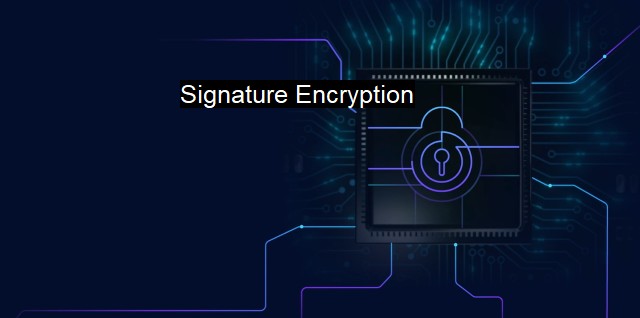What is Signature Encryption?
Understanding the Importance of Signature Encryption in Cybersecurity and Antivirus Protection
Signature encryption is a pivotal aspect of cybersecurity and antivirus strategies and resilience. It is one of the foremost tactics implemented to safeguard information from digital threats.'signature encryption' serves as electronic 'handwriting,' efficiently establishing a user's or sender's identity. It goes beyond mere verification; it safeguards the integrity of the digital information or message sent over digital channels. If say, a pen stroke or flourish unequivocally identifies the handwritten signature, the uniqueness of the key used in the encryption process is what identifies the digital signature.
Before gaining an adequate understanding of signature encryption, we need to explore concepts like encryption, digital signatures, and cryptographic algorithms, as signature encryption combines all these elements into a handy, indomitable cybersecurity tool.
Encryption is the process of scrambling data or information into an intermittently indecipherable format, shielding it from unauthorized access or exposure. Only parties with the cryptographic key can decrypt the given data, reverting it to its original, legible form. This process prevents data breach by malicious entities, ensuring the safe transition of data across digital channels.
The primary principle of a digital signature lies in its verification feature, testifying the authenticity of digital documents. A digital signature uses a mathematical algorithm that links the identity of the signer with the document. Therefore, any alteration in the document post-signing would immediately serve to invalidate the signature.
This involves 'cryptographic algorithms' or, simply put, encryption and decryption processes called 'keys.' These dual keys –a public and a private- are the compelling force of digital signatures. The public key is universally available while the private key is confined to the user. The private key is used to create the signature, and the public key to verify the same.
Signature encryption uses these functionalities of both encryption and digital signatures to provide an unrivaled level of security.
In the contemporary cybersecurity scene, cybersecurity experts leverage both symmetric and asymmetric signature encryptions. Symmetric encryption is simpler, utilizing one key for encryption and decryption of information. its vulnerability lies in the singular key being exploited. Asymmetric encryption eliminates this risk by using one key (the public key) for encryption and a separate one (the private key) for decryption. Despite asymmetric being comparatively slow, it sails over the safety barrier, comfortably gaining the upper hand.
In reference to antivirus software, signature encryption is a cornerstone for data protection. Antivirus programs need to incorporate a database of known threat signatures to identify and neutralize potential risks. These signatures need to be secured from external threats—hence the need for robust encryption.
In enabling a network to recognize who interacts with it, signature encryption consolidates the Individuality of both sender and receiver. Consequently, it inhibits illegal breaches by fostering trust in the authenticated encrypted data. While overcoming impersonation of users, it preserves the confidentiality and integrity of digital data.
Summarily, signature encryption is a bulwark against cyber invasions – it upholds the authenticity of digital interactions, enforces data integrity, it also situates itself as a reliable future-ready solution to cybersecurity risks. This electronic handwritten evidence has the potential to cement full assurance in the digital ecosystem and emerge as a significant strand debate when it comes to cybersecurity policies. It faces challenges as advancements in technology charge forward into an uncertain future, but its inherent versatility should help it adjust and adapt to shield our virtual existence from unanticipated threats.

Signature Encryption FAQs
What is signature encryption?
Signature encryption or digital signature is a cryptographic technique used to verify the authenticity and integrity of a digital message or document. It provides assurance that the message or document was sent by the claimed sender and has not been tampered with during transmission.How does signature encryption work in cybersecurity?
In cybersecurity, signature encryption involves the use of public-key cryptography to generate a unique digital signature for each file, email, or message. The sender uses their private key to sign the message, and the recipient verifies the signature using the sender's public key. If the signature is valid, the message is considered authentic and has not been tampered with.What are the benefits of using signature encryption?
The main benefit of using signature encryption is it provides a strong security mechanism to prevent unauthorized access to critical data. It helps to identify and authenticate the sender of a message and ensures that the message has not been tampered with in transit. It also helps to protect against malware and viruses that may be attached to the message.How does antivirus software use signature encryption?
Antivirus software uses signature encryption to identify and block known malware and viruses. The software scans files and messages for digital signatures that match known signatures of malware and viruses. If a match is found, the software can block the file or message from being executed, preventing the malware or virus from infecting the system.| | A | | | B | | | C | | | D | | | E | | | F | | | G | | | H | | | I | | | J | | | K | | | L | | | M | |
| | N | | | O | | | P | | | Q | | | R | | | S | | | T | | | U | | | V | | | W | | | X | | | Y | | | Z | |
| | 1 | | | 2 | | | 3 | | | 4 | | | 7 | | | 8 | | |||||||